Well, the title on the blog title does combine oboe with engineering and chronic pain. I keep forgetting fibromyalgia is an “invisible disease” until someone on Facebook shares an inspirational picture and I get sick the following weekend… two 7-day work-weeks including labour-day don’t help.
It’s just that much more upsetting when the invisible condition is typically a woman’s malaise and all I know how to do is fight it like a man! 
Well, whenever people ask why a person can get so nerdy about the oboe, all I can say is that it makes me feel better while I’m playing! |  | Eh bien, le titre du blogue combine le hautbois avec la profession d’ingénierie et la douleur chronique. J’oublie souvent que la fibromyalgie est une “maladie invisible” jusqu’à ce que Facebook affiche une image de soutien moral et je me trouve malade la fin de semaine suivante…. deux semaines de 7-jours de suite à l’ouvrage (incluant la fête du travail) n’aide pas.
C’est d’autant plus fâcheux lorsque la condition invisible est habituellement un malaise de femme et je ne sais rien faire d’autre que me battre comme un homme! 
Alors, quand les gens se surprennent qu’une personne peut s’entêter à ce point avec le hautbois, je peux juste dire que je me sens mieux en répétant! |
| YES, CLIMATE CHANGES THE INSTRUMENT! I was puzzled at IDRS 2013 (Redlands, California): the Marigaux M2 and Mönnig 150 left me indifferent after I loved it so much in New-York in 2011. I asked a number of professionals if they thought climate could be the reason. Approximately half of them told me no (only the reeds) and the other half said yes. Now I can confirm that, yes, I believe regional climate on top of day-to-day weather has huge effects on the instrument’s sound and behaviour. The first thing I did at IDRS 2014 was to find the Marigaux booth and compare the 2001 (that really impressed me last year) with the M2. Without hesitation I said “day and night”: the 2001 was still amazing, but the M2 really became my favourite again. Now Peter Cooper told me he believed the difference was due less to climate than characteristics of individual instruments… OK, except for what happened with my Lorée... I have said many times that, despite a restricted dynamic range and “wobbly” (unstable) 1st octave key notes, my Ol’ Faithful plays even better than new Royals. But it just so happened that at the conference, Lorées gave me no difficulties whatsoever: my Ol’ Faithful and all Lorées played quite nicely all week! But since my return to Ottawa, Ol’ Faithful is again exhibiting its annoying behaviours. |  | OUI, LE CLIMAT CHANGE L’INSTRUMENT! Ça m’a vraiment embêté, à IDRS 2013 à Redlands en Californie, que le Marigaux M2 et le Mönnig 150 m’ont laissé indifférent après les avoir tant aimé à New-York en 2011. J’ai demandé à un nombre de professionnels si le climat pouvait en être la cause. Environ la moitié a affirmé et l’autre a démenti (ça n’affecte que les anches). Maintenant, je peux confirmer que oui, je crois que le climat régional (en plus de la météo saisonnière) a un effet énorme sur le timbre et le comportement d’un instrument. Immédiatement en entrant à IDRS 2014, j’ai trouvé le kiosque de Marigaux et j’ai comparé le 2001 (qui m’avait impressionné l’an dernier) avec le M2. Sans hésitation j’ai déclaré “Jour et nuit!” : le 2001 continue à impressionner, mais le M2 est à nouveau mon favori. Maintenant, Peter Cooper m’a expliqué qu’il s’agirait plutôt de caractéristiques des instruments individuels… d’accord, sauf pour ce qui s’est produit avec mon Lorée… J’ai dit maintes fois que ma Vieille Branche joue toujours mieux à ce jour que même les Royals neufs, malgré ses nuances restreintes et des notes instables à la 1ère clef d’octave. Mais il se donne que pendant toute la semaine de la conférence, aucun Lorée ne m’a donné d’ennuis! Depuis mon retour à Ottawa, ma Vieille Branche a repris ses habitudes agaçantes. |
| The Ultimate Oboe: For the past couple of years, one oboe maker has been repeatedly wishing me good luck in my pursuit to find the “ultimate/ideal oboe”. This was true a few years ago, but after trying all the different makers on different occasions – and especially after comparing them in the company of other people – I no longer see it this way. Many instruments can suit a person quite well while still behaving very differently in different locations. I think the three following stories will explain. The first one was surprising: My Lorée (and all others) suddenly played fine. This was strange because my complaints remained true everywhere I’ve been in Canada (from Québec city to Windsor, Ontario… even Banff) and even in Redlands California. But in New York, in early August 2014, all fine! OK, the sound characteristics are still not to my personal taste, but that’s not a functional flaw. The return of bad behaviour on my return home makes me wonder if Providence was not playing tricks on me here!!! | 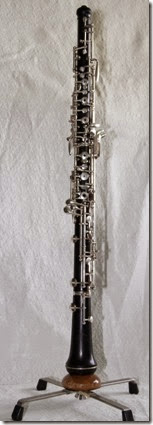 | Le hautbois ultime : Depuis quelques années, un fabricant me souhaite périodiquement bonne chance dans ma quête à trouver le “hautbois ultime/idéal”. Ceci était vrai, il y a quelques années, mais après avoir essayé presque toutes les marques à diverses occasions – et surtout après les avoir comparé en compagnie d’autres musiciens – j’ai changé mon optique. Plusieurs instruments peuvent très bien satisfaire quelqu’un même s’ils se comportent différemment à des endroits différents. Je crois que les trois histoires suivantes sauront expliquer. La première m’a surpris : Mon Lorée (et tous les autres) s’est soudain mis à bien jouer. Mes plaintes se sont confirmés partout où j’ai joué au Canada (de la ville de Québec à Windsor Ontario et Banff y compris) et même à Redlands en Californie. Mais à New-York au début d’août 2014, tout va bien! D’accord, les caractéristiques sonores ne sont pas mes préférées, mais c’est une question de goût, pas de défaut. Je me demande si la Providence ne me jouait pas des tours!!! |
| The second story is revealing. My conference room-mate, Norm Lambert, had with him a Mönnig Albrecht Mayer model, so I got to compare it with Ol’ Faithful. The Mönnig’s sound characteristics are undeniably outstanding: no orchestral oboe has a “larger presence” or richer tone colour. It definitely made tuning easier, even if Ol’ faithful was behaving well. Norm also asked me to help him compare his Mönnig, a Joseph 20th anniversary model and a Marigaux 901. The Joseph was also quite stunning and opened-up his musical spirit, but the Marigaux 901 just appeared to “fit” him better. It’s hard to explain in words, for me the instruments were almost equivalent, but for him, the 901 really responded better. The next day, he asked me to help compare two Marigaux 901: one with a synthetic top-joint and the other entirely Altunoir. Amazingly, for him the full-Altunoir clearly helped him express himself and sound fully, but for me it was the partial-wood instrument that opened my sound. |  | La seconde est révélatrice.
Mon co-locataire, Norm Lambert, a apporté son Mönnig modèle Albrecht Mayer, alors j’ai pû bien le comparer à ma Vieille Branche. Les caractéristiques sonores du Mönnig sont indéniablement sublimes : aucun hautbois d’orchestre n’a “présense plus large” ou un timbre plus riche. Il me rend aussi la justesse vraiment plus facile, même si Vieille Branche se comportait bien. Norm m’a demandé de l’aider à comparer son Mönnig à un Joseph 20 e anniversaire et un Marigaux 901. Le Joseph est aussi étonnant et ouvrit son esprit musical, mais le 901 semblait simplement mieux lui aller. Dûr à expliquer en paroles, pour moi, les instruments étaient presqu’équivalents, mais pour lui, le 901 répondait vraiment mieux. Le lendemain, il m’a demandé de l’aider à comparer deux Marigaux 901 : un avec corps supérieur synthétique, et l’autre entièrement en Altunoir. C’était étonnant à quel point le 100% Altunoir l’aidait à s’exprimer et à ouvrir son timbre, mais pour moi celui avec les corps de bois qui m’ouvrit le son. |
| Third story: Norm finally bought the full-Altunoir Marigaux 901. That night, he still had his excellent Mönnig and Fossati lent me a Model A oboe for trial, so we both had 4 instruments to compare. Clearly the Mönnig had a huge vibrant sound with both of us, but it might be better suited to a professional with the stamina to play it. Although Norm sounded fantastic on my Lorée, the Marigaux was an easy winner for him: easier on the tuning, easier on the character, easier on the depth of sound, just plain easier to make him shine. With me, the 901 was also a clear improvement on my Lorée: not quite as large sounding as the Mönnig, but less effort required to play it. There is something about the sound of the Fossati that really attracted me: almost the exact opposite of my Lorée, it combined the deep presence of the Mönnig with the fluidity of the Marigaux – not to the extent of, but rather at mid-point between them. Both the Lorée and the Marigaux have excellent and dependable mechanics, but I really like the stronger feeling of the keywork with both Mönnig and Fossati: some people call this “heavy” (yes, it is heavier) but I like the tighter feeling in the keys. They also make the extensions for the index fingers longer and more angled, very comfortable for my tendonitis-prone fingers. Which would I choose to buy?
That’s a discussion for another blog post! |
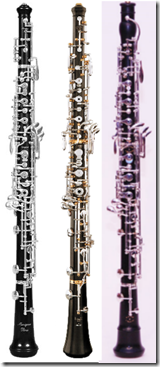 | Troisième histoire : Norm a enfin acheté l’Altunoir. Ce soir-là, il avait toujours son excellent Mönnig et Fossati m’a prêté un Modèle A en essai, alors nous avions 4 instruments à comparer. Clairement, le Mönnig nous a donné aux deux un son très large et vibrant, mais il est peut-être mieux destiné à un professionnel avec l’endurance à le jouer. Bien que Norm sonnait vraiment formidable sur mon Lorée, le Marigaux était un champion pour lui : plus facile de justesse, plus aisé sur le caractère musical, plus de profondeur de timbres et simplement plus apte à son expression. Pour moi, le 901 était aussi une amélioration nette comparativement à mon Lorée : présence moins large que le Mönnig, mais moins d’effort requis pour le jouer. Il y a quelque-chose dans le timbre du Fossati qui m’a vraiment marqué : presque l’inverse exact de mon Lorée, il combine la profonde présence de Mönnig avec la fluidité de Marigaux – pas à la limite mais plutôt une sorte de point-milieu entre les deux. Autant Lorée que Marigaux offrent une mécanique excellente et fiable, mais j’ai vraiment aimé la touche forte chez Mönnig et Fossati : certains les diront “lourds” (oui, c’est plus lourd) mais j’aime le sentiment serré dans les clefs. Ces deux derniers font aussi des extensions plus longues pour les indexes, très confortables pour mes doigts à risque de tendinite. Quel aurais-je choisi d’acheter?
C’est une discussion pour un autre article! |
| Why didn’t I buy: I have been bugging a few makers over the past few years and now I bought nothing ... my apologies for the aggravation! I actually came close to buying one of two instruments: the Marigaux d’amore or the Fossati model A. Like the Marigaux M2 I love so much, the Fossati has a deep dark sound full of presence, but it also appeals to the engineer in me, apart from being much more affordable. In the end, I bought nothing. Here is why: | | Pourquoi n’ai-je pas acheté? Depuis quelques années, j’agace un nombre de fabricants et ensuite je n’achète rien… mille excuses de tant vous embêter! À vrai dire, j’ai passé très proche d’acheter soi le hatubois d’amour Marigaux ou le Fossati modèle-A. Comme le Marigaux M2 que j’aime tant, le Fossati offre une richesse sonore, mais en plus d’être beaucoup moins dispendieux, il éveille l’ingénieur en moi. En fin de compte, je n’ai rien acheté. Voici pourquoi : |
1. My Lorée played fine in New-York.
The very first important thing, as I had always stated before: I need to ensure any instrument I buy must sound more to my liking and play in tune more easily and with dependable stability through all dynamics, compared to my current Lorée. I always hope for weather that will make Lorée and reeds play their worst, because if everything plays well, how can I really know if another instrument will not also play badly in conditions that make Ol’ Faithful cranky? So unfortunately, my reeds and all Lorées seemed to play very well in New-York... I had Ol’ Faithful tried by a few Americans and a few Europeans. The Americans said it was amazing and the Europeans complained the range using octave keys was exhausting to tune... sounds familiar? But because Ol’ Faithful played well to me (30 years of playing it gave me some habits), I could not prove that other instruments would not also go unstable when returning to Ottawa. | | 1. Mon Lorée a très bien joué à New-York J’ai toujours dit que le premier aspect le plus important en achetant un nouvel hautbois est qu’il doit améliorer mon timbre et que la justesse doit être fiable et stable dans les nuances à comparer à mon Lorée. Ainsi donc je souhaite toujours la pire météo pour faire jouer mes anches à leur pire : autrement, si mon Lorée joue bien, comment savoir que le nouvel instrument ne jouera pas aussi mal par mauvais temps à Ottawa? Alors, malheureusement, mes anches et tous les Lorées semblaient très bien jouer à New-York… J’ai fait essayer ma Vieille Branche par quelques européens et quelques américains. Les américains l’ont trouvé merveilleux et les européens se sont plaints que le 2 e octave était épuisant à jouer juste… où ai-je déjà entendu ca? Mais étant donné que Vieille Branche jouait bien à selon moi (30 ans de le jouer m’ont donné des habitudes), je ne pouvais pas prouver qu’un autre n’irait pas aussi instable au retour à Ottawa. |
| 2. Budget and don’t settle for “good in the meantime” Years ago, my wife and I declared: “we are too poor to buy cheap”. This means that buying less than the favourite ends-up making a person buy more often to progressively “upgrade”, which ends-up being much more expensive. To buy an oboe d’amore, I would need to keep my Lorée with its flaws. Right now, this is still beyond my budget. Selling my Lorée would definitely help buy a new oboe, but I cannot get the price I truly think it is worth, apart from the sentimental value of 29 years and many stories together. This year, I had a choice: buy a fantastic instrument OR gutters on the roof and paint the inside of the house (we bought 7 years ago and still never painted) and get a very important teeth-cleaning for one of my dogs… If I were a professional, then an oboe would be an investment to help pay for the rest. One other thing struck me this year: is the Viennese oboe. The reed Wolf brought this year (very different from last year) made it sound nearly identical to the baroque oboe. So between that, the exclusivity of the instrument and its considerably lower price compared to my favourites, to buy a Viennese is really not a compromise but a very interesting prospect! More investigation in order... |
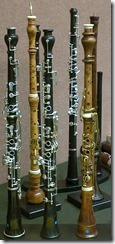 | 2. Budget et rien “en attendant” Il y a longtemps, mon épouse et moi avons convenu que nous sommes “trop pauvre pour acheter bon marché”. Ceci veut dire qu’acheter moins que l’idéal fait acheter souvent pour progressivement “mettre à niveau”, ce qui finit par coûter beaucoup plus cher. Acheter un hautbois d’amour m’obligerait à garder ma Vieille Branche avec ses défauts. Actuellement, ceci dépasse mon budget. Vendre mon Lorée m’aiderait à acheter un nouvel hautbois, mais je ne peux pas obtenir le prix que je crois vraiment qu’il vaut, à part la valeur sentimentale de 29 ans et plein d’histoires ensemble. Cette année, j’avais un choix : acheter un hautbois formidable OU les gouttières au toit, peindre l’intérieur de la maison (nous avons acheté il y a 7 ans et pas encore fait) et un nettoyage dentaire assez critique pour un de mes chiens… Si j’étais professionnel, un instrument neuf serait un investissement qui finirait par payer pour le reste. Une autre chose m’a frappé cette année : le hautbois viennois. L’anche que Wolf a apportée cette année (différente de celle de l’an dernier) l’a fait sonner presqu’identique au hautbois baroque. Alors entre ça, l’exclusivité de l’instrument et le prix considérablement inférieur à mes favoris, acheter un Viennois ne serait vraiment pas un compromis et devient un prospectus intéressant! À bien songer… |
| 3. 80% : J-L Fillon and Jacques Tys I know many people won’t believe this, but by far the main reason I did not buy has nothing to do my opinion of the instruments. It really is a matter of re-evaluating what I want to achieve artistically with the oboe. In their recitals, two performers (Jean-Luc Fillon and Jacques Tys) exuded a depth of soul that just cannot be explained in words and cannot be understood from CD or You-Tube recordings. Although they play music of extremely different styles, when they play, a connection seems to be created between my soul and something far greater than anything in this mortal world. I have been listening to saxophone players and trumpeters and flutists and pianists and every other instrument playing abstract improvisational jazz for 30 years, and honestly, it just never appealed to me: it really just sounds like random noise. NOT SO when Jean-Luc Fillon plays the same kind of music on his Lorée English Horn and Marigaux Altuglass oboe! From the simplest melody to the most ornamented licks, sometimes using only the top joint of his oboe: sheer happiness and enjoyment! I'm telling you, if Jean-Luc's playing was commonplace in modern life, all nations would be happily working to be friends and striving for enjoyment of the wondrous experiences life can bring! Apart from some clearly heavenly compositions, I personally find much of Mozart's music boorish and little more than scales and arpeggios. Holy cheeze, when Jacques Tys took out a Rigoutat and played the sonata for oboe and Piano - with melodies that should have put me to sleep – I thought I was listening to the reincarnation of Brahms, Puccini and Debussy all in one! I find most contemporary abstract music to be overly athletic, caring more for intellectual design than artistic inspiration - NOT SO when Jacques Tys played Sylvestrini! I really cannot describe the uplifting and inspirational power of his playing... at the risk of sounding aery-faery, all I can say is that I thought I was taken to heaven by Angels! This has nothing to do with the instrument (maker) they play or their technique. Jacques Tys, on his Rigoutat, got a sound more mellow than any American while showing both more power and more softness than even my aesthetics can imagine. (Sébastien Giot and Christoph Hartmann get a similar sound out of Rigoutat, but I assure you I don’t!). Same thing with the simultaneously wild yet plush sound of Jean-Luc Fillon on his Marigaux. I don’t know if they did circular breathing or not and I don’t care; I don’t know if they did double tonguing or not and I don’t care; did they do multiphonics? I DON’T CARE! What they did came from a deep relation with the music and a love that connects the artistic soul with the soul of the oboe. So I would have been very happy to buy the affordable and fully satisfying Fossati A model, but decided not to because of reason #1. I decided to buy nothing, not even a used Marigaux d’amore or a Viennese, because of reasons #2 and #3. In the end, it really is a matter of forcing myself to be less distracted with a new instrument and instead be more focused on growing artistically. In engineering terms, my Lorée is a known constant, so I can concentrate on cultivating my understanding of the musical heart. | 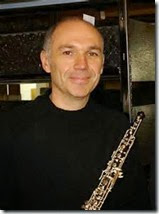
Jacques Tys
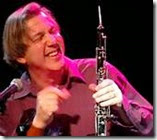
Jean-Luc
Fillon | 3. 80% : J-L Fillon et Jacques Tys Un grand nombre ne me croiront pas, mais de loin la raison principale que je n’ai rien acheté n’a rien à voir avec mon opinion sur les instruments. C’est vraiment une question de ré-évaluer mes buts artistiques avec le hautbois. Dans leurs récitals, deux interprètes (Jean-Luc Fillon et Jacques Tys) ont émané une profondeur d’âme qui ne peut pas être décrite en paroles et ne peut pas être saisie par un CD ou vidéo You-Tube. Bien qu’ils jouent de styles vraiment différents, lorsqu’ils jouent, mon âme semble être transportée vers un lieu plus vaste que n’importe-quoi dans le monde mortel. Depuis 30 ans, j’entends des saxophonistes, trompettistes, flûtistes, pianistes et toutes sortes d’instruments jouer du jazz abstrait improvisé et, honnêtement, je trouve que ce n’est guère plus que du bruit de circulation de ville. PAS VRAI lorsque Jean-Luc Fillon joue la même musique sur son cor anglais Lorée ou son hautbois Marigaux Altuglass! À partir de simples mélodies jusqu’aux passages les plus agressivement ornementés, parfois avec juste le corps du haut de son hautbois : carrément la joie de vivre! Je vous le jure, si la qualité de jeu de Jean-Luc était monnaie courante, toutes les nations du monde s’accorderaient joyeusement à s’entraider amicalement à vivre les merveilles que la vie peut apporter! À part quelques compositions indéniablement célestes, je trouve la grande partie de la musique de Mozart assez ennuyante, ne présentant guère plus que des gammes et arpèges. Sapristi, lorsque Jacques Tys sortit son Rigoutat et joua une sonate pour hautbois et piano – avec des mélodies qui normalement m’auraient endormis – je croyais entendre la réincarnation de Brahms, Puccini et Debussy tous ensemble! Je trouve la majorité de la musique abstraite contemporaine démesurément athlétique, cherchant plus les concepts intellectuels que l’inspiration – PAS VRAI lorsque Jacques Tys joue Sylvestrini! Je ne peut vraiment pas décrire l’inspiration et la puissance céleste de son jeu… au risque de paraître rêveur, je peux juste dire que je croyais être transporté au Paradis par des anges! Ceci n’a rien à voir avec l’instrument (le fabricant) qu’ils jouent ni même leur technique. Jacques Tys, sur son Rigoutat, produit un timbre plus velouté que n’importe-quel américain tout en démontrant autant de puissance et douceur que mon sens d’esthétique est capable d’imaginer. (Sébastien Giot et Christoph Hartmann en font presqu’autant avec Rigoutat, mais je vous assure que moi non!) Même chose pour le timbre sauvage, mais velouté (presque peluche) de Jean-Luc fillon sur son Marigaux. Je ne sais pas s’ils faisaient de la respiration circulaire et je m’en fiche; je ne sais pas s’ils faisaient de l’attaque double et je m’en fiche; faisaient-ils des multiphoniques? JE M’EN FICHE! Ce qu’ils faisaient vient d’une relation profonde entre la musique et un amour qui raccorde l’âme artistique avec l’âme du hautbois. Alors je serais très heureux d’acheter le Fossati modèle-A, très abordable et entièrement satisfaisant, mais je ne l’ai pas fait pour la 1 ère raison. J’ai décidé de ne rien acheter, même pas un hautbois d’amour Marigaux usagé ni un viennois à cause des raisons 2 et 3. En fin de compte, c’est vraiment une question d’éviter la distraction d’un nouvel instrument, me concentrant plutôt sur la croissance artistique. En termes d’ingénieur, mon Lorée est un facteur constant et connu, alors je peux mieux cultiver ma compréhension du cœur musical. |